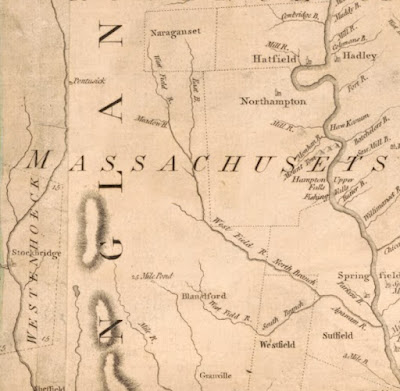After leaving Pittsfield, much of the British column of the Convention Army marched through what was then Partridgefield to Worthington, Massachusetts, where they would stay on the night of October 25, 1777. The following day some proceeded on to Chesterfield and stopped again to spend the night. Their march to Northampton on October 27th would be the halfway point in their journey from the surrender at Saratoga, New York, to their confinement in the barracks at Winter Hill in Charlestown, Massachusetts, both in days and in distance.
Worthington,
incorporated in 1764, was one of what were three Berkshire hill towns then, but five towns now, that the British column would march through from Pittsfield to Northampton.
Chesterfield, to its east, had been incorporated in 1760. Neither Worthington nor Chesterfield was marked on Captain John Montressor's 1775 map of New England, shown here in part as published in London in 1777.
Once again the journals associated with the British column provide us with only a few details of the march. Lieutenant Israel Bartlett, one of the guards with the Massachusetts militia, did note in his diary that it was a long and difficult march, writing: "[Oct.] 25 Saturday. We marched to Worthington [from Pittsfield] 20 miles, through exceedingly bad mountains and deep mud - We marched late, but got good quarters.” [1] Another of the guards recorded much the same, Private David How noting: “[Oct.] 25 This morning we Set out [from Pittsfield] march’d through the East mountain and patreidge field. at Night we Staid at Warthington”. Captured British Lieutenant Francis (Lord) Napier of the 31st Regiment of Foot would simply note: "October … 25th. Worthington 18 M[iles]". [2]
While Bartlett remained in Worthington on the 26th, Napier and How departed and marched on to Chesterfield. Napier recorded that he marched six miles, and How that: “[October] 26 This morning Draw’d provisions [in Worthington] and march’d to Chesterfield Staid at Night” [3]
How's note that the column drew provisions in Worthington illustrates the level of support required to sustain the march of the Convention Army. On October 22nd, Brigadier-General John Glover wrote to Massachusetts authorities that he would be marching two columns of prisoners and guards, numbering over six-thousand in all, across the state and that they would need to be supplied along the way. A hint as to how that was accomplished appears in Richard Wiggin's book Embattled Farmers, which details the contributions of the town of Lincoln, Massachusetts, during the Revolutionary War. In it he shares that after the surrender at Saratoga, teamsters from the town hauled supplies to Worthington for the column. [4]
It would take several day for the British column to pass through the area. While Bartlett, How and others would note that they arrived in Northampton on the 27th, some with the British 47th Regiment of Foot lagged behind. After marching only eight miles on October 27th they stopped in Worthington (where although it is not specifically noted, they likely stayed for two nights due to the storm on the 28th), and then marched seven miles to Chesterfield on the 29th, before arriving in Northampton on October 30th
. [5]
Bartlett's account offers some additional insight on the communities they passed through, and the Convention Army's impact on their residents. Writing of the 26th, a Sunday, he noted: “... we rested [in Worthington] - The people very religious. We are to march tomorrow to Northampton.” Apparently though there was a bit of confusion or disagreement between the guards and the townspeople, as on the 27th Bartlett would note: “Monday. We marched to Northampton to day, 18 miles, through the rain & mud, very fatiguing. Arrived at 2 O’Clock - Three men left came up to day and tell us that the people, we thought religious, deny our paying reckoning.” [6]
One frustrating aspect of tracking the Convention Army is that it's often not clear what roads the column marched on, including from Pittsfield through Partridgefield, Worthington and Chesterfield, and then on into Northampton.
Period maps lack sufficient detail to determine precisely which modern roads existed in 1777. Travelers passing through the area today are likely to drive east on Route 143 to Route 9 in Williamsburg (not to be confused with
Williamstown in the northwestern corner of Massachusetts which part of the column reached on October 21st), and then follow Route 9 into Northampton.
One of the earliest detailed maps of Massachusetts showing town centers, boundaries, and connecting roads was published in 1799. A section of the map, shown above with the route the column may have taken highlighted in red, suggests that passing through Williamsburg would be an option, but there is no mention of their doing so in the existing accounts of the march. That suggests that perhaps after leaving the center of Chesterfield, the Convention Army followed what is now Stage Road to East Street, and then Chesterfield Road.
Either route brings them into Northampton, which included what became the town
Westhampton in 1778, and explains why that town, though it appears on the second map pictured above, isn't mentioned in accounts of the march.
[1] Bartlett, 401.
[2] Bartlett, 401. How, 49. Napier, 329.
[3] Napier, 329. How, 49.
[4] Richard C. Wiggin, Embattled Farmers Campaigns and Profiles of Revolutionary Soldiers from Lincoln, Massachusetts, 1775-1783 (Lincoln, MA: Lincoln Historical Society, 2013), 108.
[5] 47th Regiment Journal, 157.
[6] Bartlett, 401.
For more on the Convention Army's 1777 march from Saratoga to Boston, see:





Comments
Post a Comment